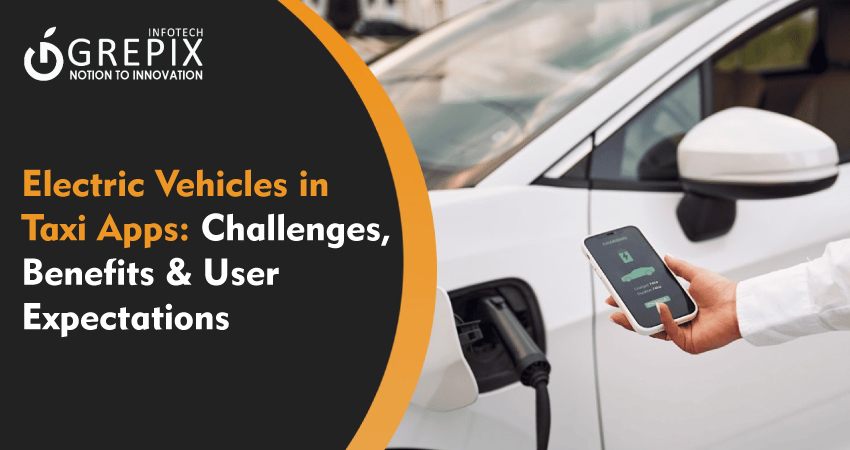Electric Vehicles in Taxi Apps: Challenges, Benefits & User Expectations
The electric vehicle ride-hailing revolution is transforming urban mobility, with green taxi apps and sustainable mobility platforms rapidly gaining ground. As global EV adoption surges 18% of new car sales in 2023, up from 4% in 2020 fleet electrification has become a strategic imperative for taxi businesses and a preferred choice for environmentally conscious users. With climate regulations intensifying and cities embracing clean air initiatives, electric vehicle ride-hailing is now vital for competitive urban transport.
Electric vehicles (EVs) are changing the face of urban mobility, with EV taxi apps at the forefront of this transformation. These platforms offer substantial environmental and economic benefits, including reduced costs for operators, lower emissions, and better air quality in cities. Faced with regulatory pressure and growing consumer demand, the green taxi app market is expanding rapidly. However, challenges such as charging infrastructure, fleet management, and high upfront costs persist. User expectations include seamless booking, real-time tracking, eco-friendly features, and transparent incentives. Looking ahead, sustainable mobility apps will integrate AI-powered routing, carbon credit systems, and autonomous vehicles to drive further efficiency and adoption. This article guides fleet operators and riders through the benefits, pitfalls, and future outlook of electric vehicle ride-hailing services starting with critical insights for anyone interested in the next evolution of urban transportation.
Benefits of Electric Vehicle Ride-Hailing
Lower Operational Costs
- EVs typically cost half as much per mile as internal combustion engine taxis, saving money on fuel and maintenance.
- Ride-hailing apps like EcoRide and Climatecars report up to an 18% city-wide emission reduction and significant savings per trip.
Eco-Friendly Branding
- Adopting EVs positions taxi apps as sustainable mobility leaders, enhancing their reputation with eco minded users.
- Cities with green taxi apps see improved public health and cleaner air, especially London and New York.
Regulatory Compliance and Incentives
- Governments offer subsidies, grants, and tax breaks for EV adoption, making fleet conversion financially advantageous.
- Compliance with emission standards (such as EU’s Fit for 55) ensures future-proof operations and avoids fines.
Improved Urban Air Quality
- Fewer emissions mean less respiratory illness and better quality of life for urban residents.
- Ride-hailing services can reduce city-wide vehicle fleet demand EcoRide retired 12,000 cars in two years.
User Incentives
- Users and drivers enjoy discounts, loyalty perks, and gamified challenges for choosing eco-friendly rides.
- EV apps now feature carbon footprint tracking, showing users their positive environmental impact.
Challenges of Integrating EVs into Taxi Apps
Charging Infrastructure
- Limited public chargers and slow charging times can hinder EV uptake for ride-hailing fleets.
- Partnerships with charging networks, private depot charging stations, and real-time charger locators are becoming essential.
leet Electrification Planning
- Fleet operators must choose EV models based on route, distance, and terrain suitability.
- Battery limitations still challenge long-distance rides and round-the-clock service, requiring smart battery management.
High Up-Front Costs
- EVs are more expensive to purchase, although lower lifetime costs often offset the initial investment.
- Governments and utility companies can help with financing and cost reduction for low-income operators.
Driver Adaptation
- Drivers require training for EV operation, including charging protocols and regenerative braking.
- Satisfaction rises with reduced fuel and maintenance costs, though managing charging schedules remains an adjustment.
Regulatory Compliance
- New policies mandate minimum EV fleet quotas, emission tracking, and interoperability with local charging infrastructure.
- Staying current with regulations across regions is necessary for sustainable expansion.
User Expectations in EV Taxi Apps
Core Expectations
- Seamless Booking:Quick, reliable app interfaces with real-time EV availability.
- Live Tracking:GPS-enabled tracking for location updates and estimated arrival times.
- Eco-Features:Battery status display, nearest charging station locator, and CO₂ savings per ride.
- Incentives:Discounts for green rides, gamification for eco-behavior, and transparent fare estimates.
- Safety and Accessibility:Night-time matching, multi-language support, and accessible interfaces for inclusive user experiences.
Real-Life User Feedback
- On platforms like Ola Electric and Lyft Green Mode, app ratings rise due to clear eco-benefits and comprehensive app features.
- Surveys show riders increasingly select “green ride” preference as default for both value and environmental impact.
Real-Life Case Studies
EcoRide: Mid-Sized City Transformation
- Boosted occupancy rates by 40%, cut emissions/trip by 18%, hit 25% EV adoption in two years, and removed 12,000 vehicles from circulation.
- Demonstrates measurable benefits for both the environment and local infrastructure.
Climatecars (London)
- CO2 emissions per trip dropped to 71g/km compared to traditional taxis at 233g/km.
- Eco-friendly branding led to higher urban adoption and better user sentiment.
Lyft, Appicial, Bolt Green
- Mass deployment of electric vehicles and ride-pooling integration drove reductions in city transport emissions and increased customer engagement.
- Features like carbon tracking and real-time charging station locators improve user bonding with the platform.
Future Outlook: Technology & Market Trends
AI-Powered Routing
- Apps use AI for predictive and battery-efficient route management.
- Reduces energy usage and improves fleet utilization.
Autonomous and Semi-Autonomous EV Taxis
- Pilots by Waymo, Tesla, and others foreshadow 24/7 fleets and drastically reduced operational costs.
Battery-as-a-Service (BaaS) and Fast Charging
- Drivers swap or lease batteries at dedicated stations, avoiding downtime and maximizing fleet efficiency.
- Being pioneered by NIO and other Asian mobility leaders.
Carbon Credit and Eco-Tracking Integration
- Green mobility apps award carbon credits per ride, adding new revenue streams and gamifying eco-friendly transport behavior.
Super Apps and Integrated Mobility
- Green taxi apps expand to integrate food delivery, groceries, carpooling, and public transport—one seamless super app experience.
Conclusion
Electric vehicle ride-hailing, led by advanced EV taxi apps and sustainable mobility platforms, is fundamentally reshaping the landscape of urban transportation. The business case is compelling: lower operational costs, eco-friendly branding, and regulatory incentives offer clear advantages to fleets and users. Yet, real challenges remain charging infrastructure, fleet conversion, and regulatory compliance demand innovation and commitment. Meeting user expectations for convenience, eco-features, and safety is critical to mainstream adoption.
Looking forward, the sector will be driven by AI-powered tools, autonomous EVs, and carbon credit systems, making sustainable mobility more accessible and impactful than ever. Entrepreneurs and fleet operators eyeing a green taxi app launch should act now: invest in technology, partnerships, and user-centered design. For riders and businesses alike, embracing electric vehicle ride-hailing is not just a smart move; it’s a responsibility to cities, communities, and the planet. Join the sustainable mobility movement choose a green taxi app and inspire others to make the shift. Share this article and power the future of clean, intelligent urban rides
FAQs
1. How does an EV taxi app reduce operational costs?
Electric vehicle ride-hailing platforms reduce per-mile expenses by leveraging cheaper electricity and lower maintenance needs, saving 45–55% over traditional cabs.
2. What government incentives exist for sustainable taxi apps?
Most nations provide tax breaks, grants, and subsidies for EV fleet conversion and public charging infrastructure deployment.
3. What must-have features are expected in a green taxi app?
Key features include real-time battery monitoring, charger locators, AI route optimization, carbon tracking, and regulatory compliance tools.
4. Are regulatory changes affecting EV taxi app adoption?
Yes. New policies like the EU's Fit for 55 and US NEVI require compliance with emission standards, charging network access, and digital fleet management.
5. Is demand for sustainable mobility apps growing?
Absolutely. Urban populations increasingly require cleaner, smarter travel options; rising EV adoption is driven by user preferences and government support.







